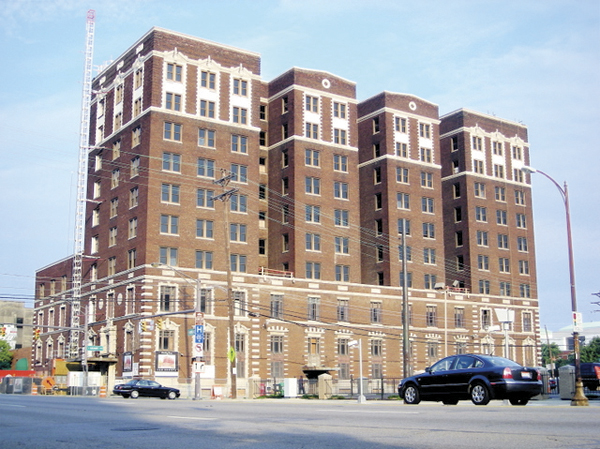|
Seneca survives, vexing officials
The following article is a tongue-in-cheek description of a great building saved from demolition. This can easily be applied to our own San Diego County saves.
In a shocking oversight, Columbus failed to demolish the Seneca Hotel. This blot on the town's record of razing landmark buildings has city officials asking what went wrong.
The Seneca, at Grant Avenue and E. Broad Street, is the kind of architectural gem Columbus developers usually grind into rubble to make way for a surface parking lot or a chain pharmacy. But this time, it didn't happen.

The Seneca Hotel in downtown Columbus, Ohio's Discovery District. Photo by Paul Bonneville
|
"There's no use trying to sugarcoat it," said an official who asked to remain fictitious. "We stood idly by while some company with vision saved a historic building. Now, instead of another soulless corner, we're stuck with something that's probably going to lend interest to the cityscape for years to come.
"Everybody's asking: Who dropped the wrecking ball?"
Completed in 1917, the Seneca was designed by Frank Packard, perhaps Columbus' most prominent architect. He or his firm designed buildings such as Orton Hall at Ohio State University, the Old Governor's Mansion on E. Broad Street and the Toledo & Ohio Railroad Depot on W. Broad Street.
Although those buildings stand, Columbus has been successful at eradicating some of the Packard firm's other efforts, including the Virginia and Chittenden hotels.
The Seneca, which became the headquarters of the Ohio Environmental Protection Agency when its hotel days were over, had been vacant since 1987 and seemed certain to fall.
But Campus Apartments of Philadelphia bought it and spent three years renovating it into rental units, with an elegant lobby and space for a coffee shop and, possibly, a restaurant.
The renovation is widely considered a setback in the ongoing campaign to drain the historical significance from E. Broad Street.
Demolitionists say, with the Seneca unrazed, the E. Broad corridor remains in danger of retaining its character as Columbus' most distinguished street.
Said one: "Every time you save something like the Seneca, you're preserving a sense of place. Instead of a forgettable thoroughfare, you have a street that people want to show off to visitors. We can't have that. There's too much beauty on Broad Street as it is. Where's the balance?"
But demolitionists point to the recent elimination of the Firestone Mansion on E. Broad as evidence that the city hasn't abandoned its long-term goal of homogenizing itself.
Were it not for some timely work by bulldozers, they note, Columbus might still be saddled with people coming from hundreds of miles away to eat at the Kahiki.
It might still have the 19th-century Union Station instead of a 21st century facsimile.
It might have a French Second Empire-style courthouse that people would visit for reasons other than pleading no contest to a misdemeanor.
"Mark my words," said the demolitionist, "when people see the beauty and life that a preservation project like the Seneca injects into a neighborhood, they're going to be asking hard questions about who let this happen and why."
By Joe Blundo. Reprinted with permission from The Columbus Dispatch, Sunday, June 22, 2008
|
MORE FROM THIS ISSUE
From the Editor
2008 Most Endangered List of Historic Resources
Character Matters
Smart Growth - or is it?
The Impact of Historic Districts
Washington Didn't Sleep Here
How to Research Your House
Preserving Community Character
Behind the Tuscany Craze
2008 People In Preservation Award Winners
Preservation Community
Reflections
Annual Financial Report
Book Review - Working Windows
Sherlock Homes
Speakers Bureau Forming
Lost San Diego
Strength in Numbers
Advertisements
DOWNLOAD full magazine as pdf (16mb)
|




